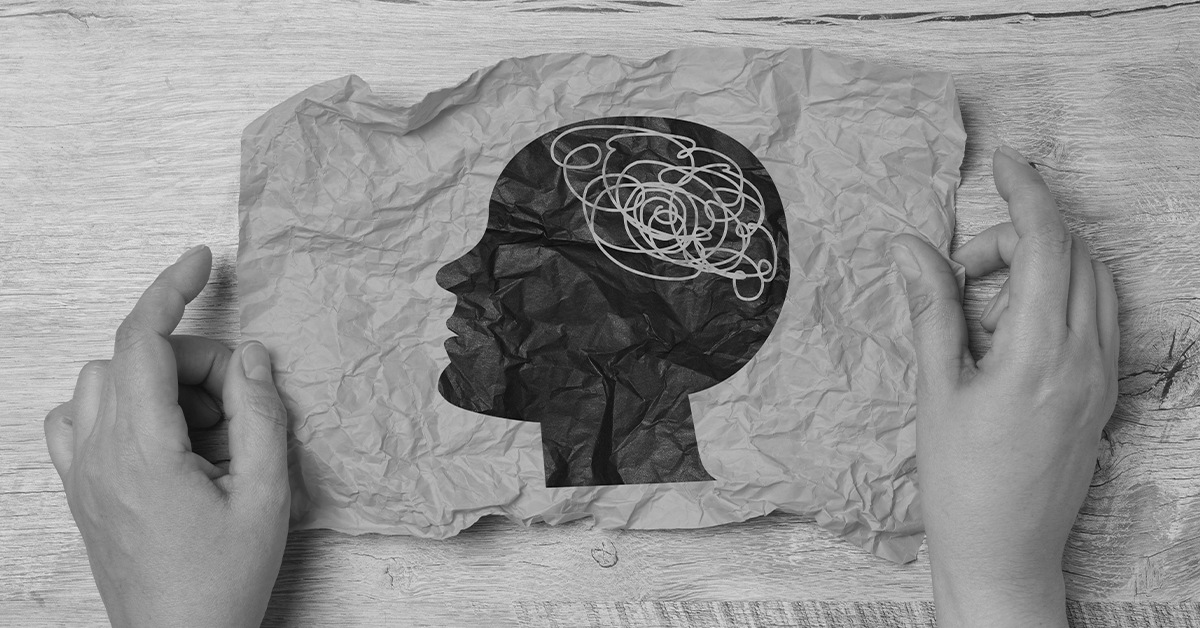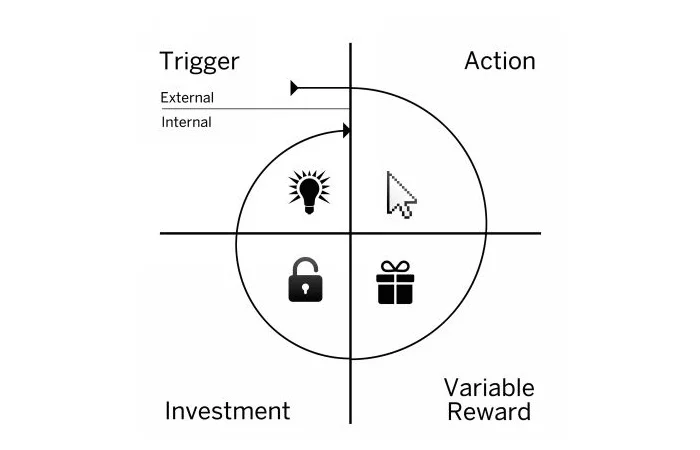Want to foster new routines but don’t know how? Would you like your customers to develop the habit of using your products and services? We’ll show you how to do it in just four steps!

Habits govern our lives. Some—like brushing our teeth or eating fruits and vegetables—are very positive. Others—like smoking or sleeping less than six hours—can be very harmful.
The inertia of habit makes it hard to change our routines, even when we know they’re not good for us. However, change is possible if we adopt effective strategies, such as the one proposed by Nir Eyal in his book Hooked.
According to Eyal, the Hooked Model is designed to “connect a user’s problem with a company’s solution frequently enough to form a habit.” However, we can also use this model to change our own behaviors through small interventions.
Below, we’ll explain how to use the Hooked Model ethically to boost your business and improve your life.
1. What Is the Hooked Model?
Hooked is a behavior change model aimed at creating and consolidating habits. It consists of four steps that repeat continuously.

To form a habit, we must first establish a set of triggers. Triggers prompt an action to occur. For example, if we want to wake up early Monday to Friday, we can set an alarm as a trigger.
The second step is to perform the action we want to turn into a habit. Ideally, start with the simplest version of the behavior. If our goal is to wake up early, it makes sense to begin with a reasonable target (e.g., getting up at 9 a.m.), and gradually increase the challenge (e.g., 7 a.m.).
But repeating the action isn’t enough to form a habit. We also need to feel rewarded when we do it. In our example, a tasty breakfast on a quiet terrace could be a suitable reward. As we’ll see later, it’s important for rewards to vary so they don’t lose their charm.
Finally, investment—in time, effort, and resources—helps strengthen the habit. Waking up early means investing effort both when we get out of bed and when we go to bed early the night before.
Triggers, actions, variable rewards, and investment are the four steps that, repeated over and over, lead us down the path of habit formation. Let’s take a closer look at each one.
2. Habit Triggers
Many daily stimuli act as triggers—app notifications, TV ads, or notes on the fridge reminding us to buy yogurt.
We can distinguish two major types of triggers: external and internal.
External triggers are found in our environment. Nir Eyal defines four categories:
– Paid triggers: Like ads. Coca-Cola’s movie theater ads reinforce the habit of drinking soda at the movies.
– Earned triggers: These come from reputation and public interest—e.g., a news article about Coca-Cola’s holiday ad reinforces soda drinking at social events.
– Relationship triggers: Advocates for a brand or lifestyle—e.g., someone who insists Coca-Cola is better than Pepsi reinforces the habit.
– Owned triggers: Deliberately integrated into daily life—like an app or a Coca-Cola fridge magnet.
On the other hand, internal triggers are those that manifest themselves automatically in our minds. Suppose, for example, that we have a bad temper. Our psychologist recommends that when we get angry with our boss, we count to ten before responding. We listen to him. Every time we feel anger, the discomfort acts as an internal trigger for the action of counting to ten.
Through external triggers, big brands manage to incorporate internal triggers into our daily lives. If every time you feel thirsty, you go to the fridge for a Coca Cola, then thirst is acting as an internal trigger in favor of the brand.
3. Action Motivation: Doing It Without Thinking
For a behavior to become a habit, it needs to start as simply as possible.
Six factors make actions harder:
– Time
– Money
– Physical effort
– Mental effort
– Social deviance
– Lack of routine
If we want a person to acquire a habit, we must try to make the behavior brief, inexpensive, requiring little physical or mental effort, consistent with social norms, and fitting into their routine.
Duolingo, for example, has managed to simplify something as complex as learning a language. Short sessions, free or very affordable, always available on your phone, very popular, and easy to fit into your daily routine. That’s why it’s such a successful app.
4. Variable Rewards: Variety is the Spice of Life
Humans quickly adapt to rewards. As they repeat, they lose impact. That’s why variable rewards are key in the third step of the Hooked Model.
In the case of digital platforms, their variable rewards are usually integrated into their dynamics. Social media, for example, rewards us with notifications informing us of followers, memes, news, etc. This way, when a social media notification pops up, we don’t know what we’re going to find and we try to find out as soon as possible. If we always received the same type of notifications, our willingness to interact with social media would be much lower.
Variable rewards are also effective in the private sphere. Think of parents who reward their child when he gets good grades. Sometimes they pay for concert tickets. Other times, they order food from his favorite restaurant. And most of the time, they simply congratulate him. Thus, variable rewards are never taken for granted and remain effective over time.
Nir Eyal distinguishes between three types of rewards: tribe rewards, hunting rewards, and personal rewards.
Tribal rewards are what make us feel accepted, attractive, important, and included. Facebook likes, Instagram likes, and Twitter retweets are rewards of this type.
The rewards of hunting are trophies that allow us to display our achievements. Money is, in itself, a form of trophy, but so are sports medals, video game scores, and academic diplomas.
Finally, personal rewards are those related to our own personal development. Learning a language or improving our physical performance thanks to an app is also a reward.
5. Habit Investments: Committing to Action
As we invest time, effort, or resources in an action, we are more willing to value it positively and repeat it. This is what happens when we use apps. If we spend our time listening to music on Spotify, put effort into setting up our playlists, and pay a monthly fee, we will be more willing to continue using that platform than to use a different one, even if it is objectively better.
Our past behaviors generate inertia and consolidate habits, even affecting our identity. When we say that we are “more Android” or “more iOS,” we are affirming an identity commitment that manifests itself in our behavior.
In addition to investing time, effort, and resources in a product, service, or platform, we can also invest:
– Content.
– Information.
– Followers.
– Reputation.
– Skill.
On social media, these types of investments are particularly clear: we create content (photos, messages, memes, etc.), accumulate information that we save in our favorites, gain followers, build a reputation, and acquire a certain ability to communicate and have an impact.
Accumulating content, information, followers, reputation, and skill in one space makes it much more difficult to leave and encourages us to return to it again and again.
6. How Big Companies Get You Hooked
Large companies have been using the Hooked Model for many years to create habits in consumers. Let’s look at a few examples:
Instagram
– Trigger: Notifications about likes, messages, and followers
– Action: You open and interact with the app
– Variable reward: Photos, memes, chats, new people
– Investment: You post stories, gain followers, and build your profile
Netflix
– Trigger: A push notification or email alerts you about a new episode
– Action: You open the app and watch
– Variable reward: Entertainment and talking points
– Investment: You build watchlists and improve algorithmic recommendations
Vips (Restaurant chain)
– Trigger: Ads about new menu items
– Action: You go to the restaurant
– Variable reward: You try new dishes
– Investment: You spend time and money regularly
7. Habit or Addiction? The Ethics of Interventions
The line between a habit and an addiction is not always as clear as we would like it to be. Do we have a habit of checking our social media or are we addicted to its content? Do we have a habit of eating hamburgers or are we addicted to junk food? Do we have a habit of buying clothes every month or are we addicted to shopping?
An addiction is a compulsive and persistent behavior that harms us when we engage in it and causes profound discomfort when we don’t. By definition, it is self-destructive. Drug abuse is the clearest example of an addiction.
Habits, on the other hand, are recurring behaviors that are spontaneous but not compulsive and that generate well-being.
However, a habit can lead to addiction if you are not careful enough or use inappropriate strategies. How can you encourage healthy habits?
– Set limits: Limit the time, effort, and resources that will be devoted to a behavior and establish warning signs. For example, to prevent your users from developing an addiction to your app, warn them when they spend too much time or money on it.
– Disable unnecessary triggers: The constant bombardment of notifications contributes to compulsive behavior and the search for immediate and constant rewards. Disable triggers from time to time so as not to burn out the habit.
– Be critical of content: Digital spaces often offer an idyllic view of reality that is much more attractive than the world around us. To avoid getting caught up in a fantasy world, critically analyze content and point out aspects that do not correspond to reality.
8. How to Promote Habits in Your Customers
Would you like to apply the Hooked Model in your company or institution? Just follow the four steps we have reviewed.
Let’s say you are a new digital bank and want to encourage your customers to use your app regularly. What could you do?
First, identify the triggers you can set up at each point of contact between your organization and your customers. You can, for example, send push notifications, pay for ads, or send emails with news.
Next, make the action easy. If you want customers to use your app, place the elements they interact with most, such as credit cards or investment products, in plain sight.
Then, reward behavior. Congratulate recurring users on their birthdays and special dates with small gifts. They don’t have to be very expensive, but they do have to add some kind of value.
Finally, encourage different forms of investment. If you can get your customers to manage their entire financial life on your app—payroll, bills, loans, insurance, etc.—they will be much more likely to stay with you in the long term.
Once you have completed the four steps, measure the success of each one, incorporate improvements, and iterate indefinitely.
Conclusions
The Hooked Model is a useful and simple tool that, in just four steps, helps individuals, companies, and institutions develop healthy habits. Large companies have been using it consciously or unconsciously for many years, and its success is palpable. If you also want to take advantage of its benefits, start using it today. Remember that you can count on us to implement it using effective behavioral science strategies.
Are you interested?
Get in touch!
